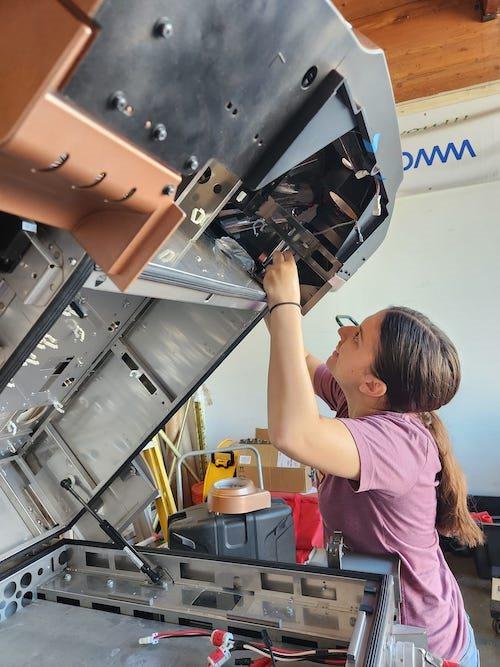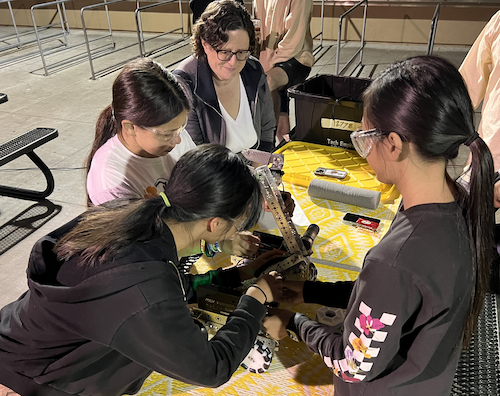When Excitement STEMs From Action
By Bahadir Community Member
One hot August day in Tempe, Arizona, my wife LeAnn and I were sitting with our younger daughter, Bria, in the pleasant front courtyard of the freshman engineering dorm at Arizona State University, Bria’s new home for that year. LeAnn looked at me and asked, “Isn’t that guy walking towards the bridge from Bria’s FTC robotics team?” That was when we happily found out that two members from our first First Tech Challenge (FTC) Robotics team at Black Mountain Middle School had continued to pursue their interest in tech and were current engineering students at ASU!
It’s this retention that needs to happen to support the upward trend in science, technology, engineering, and math (STEM). Based on National Science Foundation (NSF) statistics, the STEM labor force in the U.S. increased by 50% between 2010 and 2019. Now extrapolate this to the need for STEM in 2030 and understand the necessity of our contribution as parents, professionals in STEM, and educators. The best way for us as a nation to support our continuing development and leadership in STEM is to encourage, guide, and educate the young women in our lives during elementary, middle, and high school, as they play a vital role in fueling the trend for STEM graduates.
"Life need not be easy, provided only that it is not empty."
– Lise Meitner, physicist
Having been in the engineering world for more than 30 years, I always felt that missing equal representation from half of the population just did not make sense. When our daughter started showing interest in science and math in elementary school, we encouraged her by finding exciting ways to channel her enthusiasm. She enjoyed building catapults for the science fair, the VEX IQ robotics summer camp we found for her, and when she started middle school, she wanted to join her school’s First Lego League (FLL) robotics program. In order to support her, I signed up as a co-coach, and the year after, LeAnn and I took on coaching a mostly girls’ team together. By the end of seventh grade, we wanted to create an advanced program for the students at Bria’s middle school to further her and her friends’ enthusiasm for robotics. After analyzing both VEX IQ and FTC, we picked FTC and launched it to add to the FLL program as an option for seventh and eighth graders. During that launch year, LeAnn took the position of Head Coach for both FTC and FLL programs, and I became the coach for one of the two FTC teams.
As we were getting the program off the ground, I approached my employer, Cadence, for support. Cadence has a mission to support nonprofits where employees live and work, as well as support the future of STEM. Our school received a grant to support these robotics teams in their first year. The funds were invaluable not only for the morale of the teams, but were happily used towards the purchase of one of the three robotics kits we obtained for the two teams that year! After six seasons, including the difficult pandemic years, that FTC program is now in its seventh season with three teams, one of which is an all-girls team!
There are many girls interested in science, engineering, and math in elementary and middle schools across the country. Through programs like these, we can engage their curiosity and keep their interest alive, significantly increasing the number of women participating in STEM in the workplace! The valuable contribution of women will be a significant way for us to fulfill the continuously growing need in the STEM workforce.
"Science is not a boy's game; it's not a girl's game. It's everyone's game."
– Nichelle Nichols, former NASA Ambassador and Star Trek actress
Since the Industrial Revolution, the role that science and technology play in our lives has been growing by leaps and bounds. The significant acceleration we saw first with the personal computer revolution of the 1980s and the introduction and proliferation of the internet in the 1990s created many new areas of growth and the consequent need for more and more STEM professionals in the U.S. The same growth continued with the connectivity explosion that smartphones brought between 2005 and 2015, and now we are going through yet another such breakthrough with AI/ML. The tech industry continuously develops a hard-to-satisfy hunger for hardware and software engineers, with microchips prevalent everywhere that are setting the foundation for more and more software. The need for engineers, scientists, and other STEM professionals to fuel this growth sets us at a decision point in history for preparing the next generations. If you work in a technical field and need to hire scientists and engineers regularly, you should start your campaign for 2030 and beyond by taking part in growing the pool of talent to recruit from. Students engaged in STEM are the future!...and it’s our responsibility to support them.
"I'm not a woman at Google but a geek at Google. And being a geek is just great. I'm a geek, I like to code, I even like to use spreadsheets when I cook."
– Marissa Mayer, former CEO of Yahoo
We can advance our technological growth and improve our impact by working to fully integrate women, 50% of our population, into STEM, where they have been frequently underrepresented in the US. In 2013, a National Public Radio report said 20% of computer programmers in the US are women. While there is no consensus on the reason there are fewer women in computing, it’s our responsibility, as parents, as educators, and as industry professionals, to expand access and engagement in STEM, for our kids, our students, our industry, and our society. By encouraging and enabling expanded diversity in this exciting and stimulating environment, we can also help narrow workforce income gaps by filling higher-paying jobs in the engineering and science fields with a diverse group of women. They will also bring new ideas and new approaches to problems and will have a positive larger impact overall than they will just with numbers.
“If not you, then who? If not now, when?”
– Hillel the Elder, 1st-century philosopher
We need a significant change and this begins with us. Studies show that many more girls are interested in STEM during elementary school than during high school. This interest appears to peak around age 10-11 and then wane throughout middle school and early high school. Most that make it to around age 15 with their enthusiasm in STEM intact end up going the whole way. Consequently, the best time to support STEM learning is the middle school years. These are the years when girls most need active encouragement from everyone around them—parents, teachers, and other industry professionals—in order to be able to fight the trends that turn them off of their earlier interest in STEM.
“If you are offered a seat on a rocket ship, don’t ask what seat! Just get on.”
– Sheryl Sandberg, COO of Facebook
There are many seats on this rocket and there are many ways to facilitate girls’ interest in STEM. Many programs such as FIRST (robotics), Science Olympiad (science and engineering), Cyberpatriot (programming), VEX Robotics Competition, and Girls Who Code—to name a few—are already in existence. These are all volunteer-led, volunteer-organized, and volunteer-populated programs with the critical bottleneck of not enough volunteers. Therefore, one of the key actions you can take as parents to show your commitment to your daughters and their friends is to volunteer to be a coach, mentor, or helper at these organizations and events. Keep in mind that you can best motivate them by demonstrating what is important to you by donating your time to them and others like them. And like LeAnn and I tell all the parents all the time, you do not need to be an engineer to be a coach or mentor. Those students are already competent engineers, they just may not know it yet. They need our organizational skills, presence, and guidance so that they can build, code, learn, and grow.
We are busy at work and in life, but this can be part of the time you share with your kids and their friends as they grow. As educators, encourage your students and their parents to get involved with these programs and help parents organize such programs at your own schools. The key resource volunteers need from teachers and school administrations is often logistical help in terms of a regular team meeting place such as a classroom and a teacher sponsor. And my fellow engineers and STEM professionals: Visit middle schools and excite them about science and technology; about your work and about future possibilities. They especially need to see women role models! They need to see what they can become and that it’s possible. Be those role models for them at career events and at STEM programs or be the partners to those role models. Just like the two JPL Space Systems Engineers that Bria met at the San Diego STEM Fair many years ago—they were the main drivers for the Dawn spacecraft.
“When I was in high school, I was certain that being an astronaut was my goal. Sally Ride was making her first flight into space and she had a real impact on me.”
– Karen Nyberg, NASA astronaut
Engineering at its basis is problem solving and science originates from our curiosity and desire to learn. At the end of every year of robotics, if the students finish the season with their problem-solving skills enhanced, their curiosity to learn further vetted, and their desire to continue doing STEM increased, LeAnn and I consider it a success. This year we are excited to finally have enough girls interested to have an all-girls FTC team and they are doing amazingly well!
Our ask from you is to choose how you can help women pave the way to our future in STEM. Be a coach, mentor, organizer, educator, sponsor, and most importantly, be a positive role model! Come up with creative ways to volunteer in the next three months for at least one activity that promotes STEM to middle school girls.
For Thanksgiving this year, our family will be in Arizona because our Astronautics Engineering sophomore has her exams the following week. The whole family is looking forward to the road trip and Thanksgiving! We hope you also get to enjoy similar occasions.




